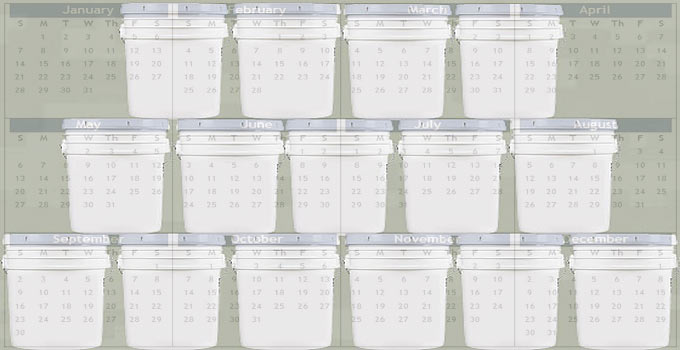Long Term Storage Food For 1 Year – How Much Food Is That?
Guest post by ‘Anony Mee’
Ken’s recent post “15 Reasons Why You Need Food Storage” called to mind an earlier post “Bare Minimum Food Storage List For One Year” which was based on the LDS recommendations for one person for one year of 755 total pounds of various long-term storage food, broken into seven categories.
I’ve been wanting to calculate what it takes to establish a pantry of long-term storage food. The recommended amounts of pounds per year for each category of food made me wonder, “How much food is that?”
So, I broke down each category a bit, calculated amounts of uncooked ingredients, calories, and grams of protein for a cooked amount of each food and built a matrix.
It’s not too granular, but does provide close to the LDS-recommended pounds per year.
>> LDS Preparedness Manual by Christopher Parrett
(view on amzn)
Here’s what I came up with:
Grains = 400 lbs per year
Whole grains (wheat, rye, buckwheat, etc.), flours, cold cereals, hot cereals, pasta, noodles, popcorn, yeast bread, quick bread, flat bread, crackers, pastries, coatings, thickeners, snacks, misc. whole grain dishes
Daily: 8-10 slices of bread, 1-1/2 cups cooked pasta, 2 cups cooked rice, 1 cup cooked oatmeal, 4 cups popped popcorn, AND 1/2 cup misc.
[ Read: How Much Wheat In A 5 Gallon Bucket – Pounds, Calories, Loaves Of Bread ]
Beans & Legumes = 90 lbs per year
Dried beans of all sorts, split peas, lentils
Daily: 3/4 cup cooked beans, 2/3 cup cooked lentils, AND 3 tablespoons cooked split peas
[ Read: Rice & Beans, A Survival Combination ]
Milk & Dairy = 75 lbs per year
Powdered/Instant dry milk for drinking, baking, cooking, and gravies; freeze-dried cheese
Daily: 2-1/2 cups reconstituted nonfat milk, AND 1/4 cup reconstituted cheddar cheese
[ Read: DIY Long Term Food Storage ]
Meat = 20 lbs per year
Freeze dried beef, chicken, pork, turkey
Daily: 3 tablespoons reconstituted ground beef, AND 1/4 cup reconstituted chicken chunks
[ Read: Freeze Dried Ground Beef ]
Fats = 20 lbs per year
Oils, butter, shortening, lard, bacon grease – all kept frozen – for cooking, baking, dressings and sauces
Daily: 2 tablespoons olive oil
[ Read: Round Out Your Food Storage After Basic Goods Are Laid In ]
Sugars = 60 lbs per year
Granulated sugar, powdered sugar, honey, molasses, syrups, jam/jelly, candy
Daily: 1-1/2 tablespoons of dry sugar, AND 2-1/2 tablespoons of honey
[ Read: Raw Honey For Nutrition and Medicine ]
Fruit & vegetables = 90 lbs per year
Freeze-dried fruit, freeze-dried vegetables, instant potatoes (mashed, cubed, hash browns)
Daily: 1-1/4 cups reconstituted fruit, 1-1/4 cups reconstituted vegetables, AND 1+ cup cooked potatoes
[ Read: You Won’t Be Eating Much (or any) Meat After SHTF ]
This all yields around 3,500 calories per day, a little on the high side for what we need, based on the family’s anticipated levels of exertion.
This matrix is simply a guide that I’ll adjust along the way.
Here’s the spreadsheet:
one-year-long-term-storage-food-lds.xls
The LDS recommendations are fine, but I can tell you that I’ll be planning to store less grain, legumes, and fruit, more meat, oil, and vegetables, and much more cheese. A reflection of our preferences, and because I am concerned that excessive flatulence might yield undesired results within the community (hee hee).
Including columns for desired amounts, inventory on hand, and cost per unit will give me a budget and a therefore a timeline for accomplishing my long-term food storage goal.
MORE FOOD NEEDED?
More would be needed to help provide for unexpected arrivals, supplement neighbors, and afford handouts to a few strangers who show up at the door now and then.
ADDITIONAL FOOD DIVERSITY
In addition would be long-term storage staples for my family/group of FD peanut butter, grains for making sprouts, FD eggs, and FD sausage crumbles (just gotta have those biscuits and gravy).
Plus grains, eggs/meat, oil, and veg for homemade pet food. Also, yeast and other leavenings, salts, spices, herbs, flavorings, vinegars, various condiments and sauces or their component ingredients, including extra oil for mayonnaise, and tomato powder for ketchups and sauces.
And ingredients for canning, preserving, and processing the garden, orchard, and other food sources, and gluten-free grains for one DFM.
Reconstituting and cooking all these ingredients would take at least a gallon of water per person per day.
NUTRITIONAL SOURCE
A more detailed breakdown of nutrition for each food can be found at any number of websites. The one I used for most of these was nutritionix.com. For freeze-dried meat, cheese, and all fruit and vegetable equivalents, I relied on ThriveLife’s nutritional labels.
– Anony Mee
[Ken adds:] There are a bazillion ways to go about long term storage food for one year. When I first started serious planning years ago I came across the LDS Preparedness Manual which was one of the many references that guided me towards what I have today.
I believe the key to successful long term food storage is a diversity of many food types.
It’s surprising how much food it is when you consider 1 year!
[ Read: Survival Food Most Common In Preppers Deep Pantry Storage ]

